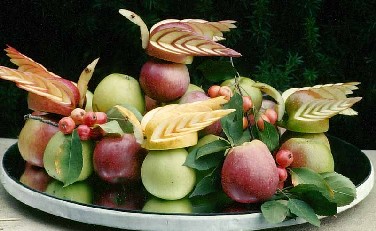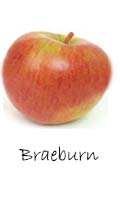
Varieties of Apples from North America

On a linear ranking of sweet to tart, typically, Fuji and Gala apples are at the sweet end of the chart and Granny Smith and Braeburn at the tart end, with the other varieties falling in between. There is so much more to an apple eating and cooking experience than just how sweet or tart it tastes. Sometimes the magic happens in the in-between.












Rice is the most important grain with regard to human nutrition and caloric intake, providing more than one-fifth of the calories consumed worldwide by humans. There are many varieties of rice and culinary preferences tend to vary regionally.
The varieties of rice are typically classified as long-, medium-, and short-grained. The grains of long-grain rice (high in amylose) tend to remain intact after cooking; medium-grain rice (high in amylopectin) becomes more sticky.
Medium-grain rice is used for sweet dishes, for risotto in Italy, and many rice dishes, such as arròs negre, in Spain. Some varieties of long-grain rice that are high in amylopectin, known as Thai Sticky rice, are usually steamed.
A stickier medium-grain rice is used for sushi; the stickiness allows rice to hold its shape when molded. Medium-grain rice is used extensively in Japan, including to accompany savoury dishes, where it is usually served plain in a separate dish. Short-grain rice is often used for rice pudding. Instant rice differs from parboiled rice in that it is fully cooked and then dried, though there is a significant degradation in taste and texture. Rice flour and starch often are used in batters and breadings to increase crispiness.
Wild Rice is a naturally grown aquatic grass seed, not a farm crop. Unlike much of the rice you find in your local grocery stores, true natural Wild Rice is not genetically modified and is grown without the use of fertilizers or pesticides. Wild Rice grows on non-depleted soils at the bottom of pristine lakes, it is always growing and reseeding itself naturally. Once harvested, even over time it will retain the same nutrient value and flavor.
48 recipes selected, Page 1 of 3
-
-
-
-
-
-
-
-
-
-
-
-
-
-
-
-
-
-
-
-
48 recipes selected, Page 1 of 3

On a linear ranking of sweet to tart, typically, Fuji and Gala apples are at the sweet end of the chart and Granny Smith and Braeburn at the tart end, with the other varieties falling in between. There is so much more to an apple eating and cooking experience than just how sweet or tart it tastes. Sometimes the magic happens in the in-between.












Rice is the most important grain with regard to human nutrition and caloric intake, providing more than one-fifth of the calories consumed worldwide by humans. There are many varieties of rice and culinary preferences tend to vary regionally.
The varieties of rice are typically classified as long-, medium-, and short-grained. The grains of long-grain rice (high in amylose) tend to remain intact after cooking; medium-grain rice (high in amylopectin) becomes more sticky.
Medium-grain rice is used for sweet dishes, for risotto in Italy, and many rice dishes, such as arròs negre, in Spain. Some varieties of long-grain rice that are high in amylopectin, known as Thai Sticky rice, are usually steamed.
A stickier medium-grain rice is used for sushi; the stickiness allows rice to hold its shape when molded. Medium-grain rice is used extensively in Japan, including to accompany savoury dishes, where it is usually served plain in a separate dish. Short-grain rice is often used for rice pudding. Instant rice differs from parboiled rice in that it is fully cooked and then dried, though there is a significant degradation in taste and texture. Rice flour and starch often are used in batters and breadings to increase crispiness.
Wild Rice is a naturally grown aquatic grass seed, not a farm crop. Unlike much of the rice you find in your local grocery stores, true natural Wild Rice is not genetically modified and is grown without the use of fertilizers or pesticides. Wild Rice grows on non-depleted soils at the bottom of pristine lakes, it is always growing and reseeding itself naturally. Once harvested, even over time it will retain the same nutrient value and flavor.
48 recipes selected, Page 1 of 3
48 recipes selected, Page 1 of 3
























